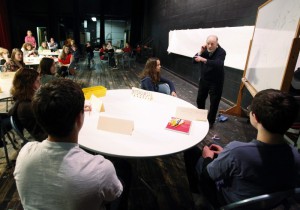A couple of weeks ago the Boston Modern Orchestra Project performed my piece Letter From Mozart and the music of three other Canadian composers—Kati Agócs, Colin McPhee and Claude Vivier. Here is an excerpt from the Boston Classical Review:
Geographically, Canada is not that far away from Boston. Some of the Canadian music heard Sunday afternoon at Jordan Hall, however, sounded like it was coming from a much greater distance. …
Michael Colgrass’s Letter from Mozart was by far the most complex work on the program, and the most successfully executed. Set for large ensemble, Letter takes a theme from Mozart, stated crisply by Osborn-Blaschke to start the proceedings, and embarks on a journey that might be called “theme and incomplete variations.”
Colgrass layers the thematic explorations for various instrumental combinations in a musical style that manages to successfully straddle the line between serious and sardonic. The musical argument grows so dense that two conductors (Rose, assisted by Andrew Clark) are necessary. Yet what could become musical mayhem — overlaid sections, shifting harmonies — comes off as mysteriously affecting. The comic moments — at one point a polka tries to emerge, only to be interrupted — provide a countermeasure to the prevailing poignancy.
I read the BMOP review while visiting Mt. Horeb, Wisconsin, where I was teaching middle and high school students how to compose music with graphic notation. Luckily the journalist who covered it for the Wisconsin State Journal is a music lover:
MOUNT HOREB — Michael Colgrass spent his time in high school music classes trying to add to his collection of spitballs on the classroom ceiling because his teachers made learning and understanding music a boring chore.
As his career as an award-winning composer winds down, the 79-year-old Colgrass has returned to the classroom — including a four-day residency at Mount Horeb High School that began Wednesday — as an acclaimed teacher who emphasizes fun and creativity while taking simple sounds and turning them into a special piece of music.
There are no spitballers in sight. Just budding composers.
“I see these kids and I think energy, brightness, creativity. Bring it out. Develop it. Don’t let it go sideways and end up in the street someplace,” Colgrass said.
Colgrass, an American who lives in Toronto, is one of the most distinguished composers in the world. He won the Pulitzer Prize for Music in 1978 for “Déjà vu,” which was commissioned and premiered by the New York Philharmonic Orchestra. He also won an Emmy, two Guggenheim Fellowships, a Rockefeller Grant and other awards.
Colgrass, who also is spending time at Madison Edgewood High School this week, was brought to the Mount Horeb music department thanks to a donation by an anonymous couple who stipulated it be used for something unique that would affect as many students as possible.
“Part of what his approach does is free your imagination to hear what you’d like to hear and then figure out how to write it instead of being so concerned about the mechanics of the writing that you lose the creative element,” said Mount Horeb band director Will Janssen.
By the time Colgrass leaves, the group of high school and middle school students will have composed music that will be performed at a concert Saturday night. And they will have composed it by representing sounds on paper with a line, figure or a series of dots he calls a soundscape.
The notes come later. Much, much later.
The students in the composing group kept an open mind Wednesday as they prepared to make music. “We’re not sure if it’s an effective way to make sure we get what we want written out. But we’ll give it a try,” junior Andrew Hill said.
“If you come at this with a closed mind, you definitely aren’t going to like it because you are drawing music,” he added.
Colgrass sometimes wonders before the concert what parents and teachers will think about the students’ music.
“Are they going to say, ‘That doesn’t sound like music. Where’s the melody?’ But they don’t,” Colgrass said. “If you first explain to them the process, they are always excited about it and like it. They seem to understand.”
